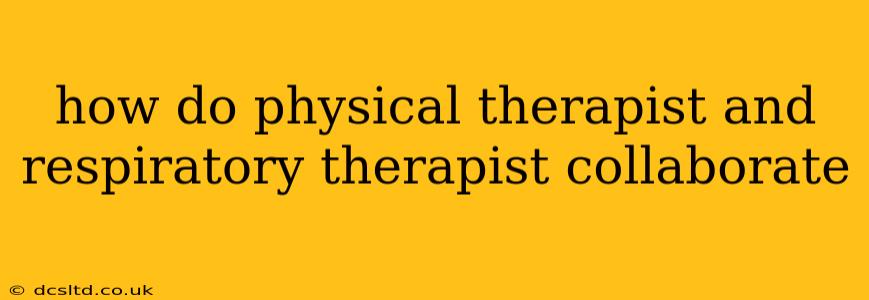Physical therapists (PTs) and respiratory therapists (RTs) are healthcare professionals who often work together to improve the health and well-being of patients, particularly those with respiratory or cardiopulmonary conditions. Their collaborative efforts are crucial for optimizing patient outcomes and ensuring comprehensive care. This collaboration hinges on a shared understanding of the patient's condition, goals, and the potential benefits of combined interventions.
What are the Key Areas of Collaboration Between PTs and RTs?
The collaboration between PTs and RTs often centers around patients with conditions affecting both respiratory and musculoskeletal systems. Here are some key areas of overlap:
-
Post-surgical rehabilitation: Following lung surgery (e.g., lobectomy, pneumonectomy), both PTs and RTs play vital roles. RTs focus on airway clearance techniques, breathing exercises, and managing oxygen therapy, while PTs focus on improving mobility, strength, and endurance to aid in recovery. Their combined approach ensures a holistic and effective rehabilitation process.
-
Chronic obstructive pulmonary disease (COPD) management: Patients with COPD often experience both respiratory limitations and decreased muscle strength and endurance. PTs work on improving exercise tolerance and functional capacity through targeted exercises, while RTs focus on airway clearance, breathing retraining, and oxygen therapy management. This combined approach helps improve quality of life and reduce exacerbations.
-
Cystic fibrosis (CF) care: Individuals with CF benefit from the collaborative expertise of PTs and RTs. RTs address airway clearance and manage respiratory infections, while PTs address chest wall mobility and overall physical fitness. Their coordinated efforts help maintain lung function and improve overall health.
-
Post-intensive care unit (ICU) rehabilitation: Patients recovering from critical illness often require extensive rehabilitation. PTs and RTs collaboratively address breathing exercises, mobility, and endurance deficits, ensuring a smooth transition from ICU to inpatient or outpatient rehabilitation.
-
Cardiac rehabilitation: Patients recovering from cardiac events may experience both respiratory and physical limitations. PTs focus on improving cardiovascular fitness, while RTs focus on optimizing respiratory function. Their joint efforts help patients regain strength and endurance safely.
How Do PTs and RTs Communicate and Coordinate Care?
Effective collaboration requires clear communication and a well-defined plan of care. This often involves:
-
Joint patient assessments: PTs and RTs may jointly assess the patient's respiratory and musculoskeletal status, identifying areas where combined intervention can be most beneficial.
-
Shared treatment plans: Collaboration allows for the development of a comprehensive treatment plan that addresses both respiratory and physical needs, preventing conflicting or redundant interventions.
-
Regular communication: Frequent communication (e.g., through electronic health records, team meetings, or informal discussions) ensures that both professionals are aware of the patient's progress and any changes in their condition.
-
Mutual respect and understanding of each other’s roles: Each profession's unique expertise and skill set are acknowledged and valued.
What are the Benefits of Collaboration Between PTs and RTs?
The collaborative approach between PTs and RTs offers several key benefits:
-
Improved patient outcomes: A coordinated approach leads to more effective and efficient rehabilitation, resulting in better functional outcomes and improved quality of life.
-
Reduced hospital stays: Efficient and effective collaborative care can shorten the duration of hospital stays, leading to cost savings.
-
Enhanced patient satisfaction: Patients benefit from a holistic approach that addresses both respiratory and physical needs, leading to higher satisfaction levels.
-
Increased efficiency: Effective communication and coordination streamline the treatment process, reducing redundancy and improving overall efficiency.
How can a patient ensure their PT and RT are collaborating effectively?
Patients can advocate for effective collaboration by:
-
Asking questions: Don't hesitate to ask your PT and RT about their treatment plans, how they will collaborate, and what the expected outcomes are.
-
Open communication: Keep your healthcare team informed of any changes in your condition or concerns you may have.
-
Active participation: Actively participate in your rehabilitation program, following instructions and providing feedback to your PT and RT.
In conclusion, the collaboration between physical therapists and respiratory therapists is crucial for optimizing patient care, particularly for individuals with conditions affecting both the respiratory and musculoskeletal systems. Their coordinated efforts lead to improved patient outcomes, enhanced efficiency, and increased patient satisfaction. Open communication and a shared understanding of roles are essential for successful collaboration.
